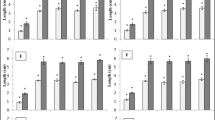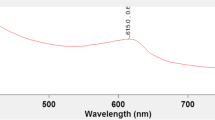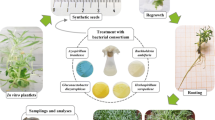Abstract
The East Indian sandalwood (Santalum album L), one among the valued timber species in the global market due to its sweet-scented heartwood, is facing a drastic decline of its natural populations over the past three decades. The major constraint in the regeneration of sandal is the slow, staggered, and poor germination of the seeds. The germination may continue even up to one year. The present investigation focused on the impact of biopriming on the germination and seedling performance in sandal. Fresh mature seeds of sandal were procured from the Nachivayal Reserve Forest, Marayur Sandal Division. The seeds were subjected to 16 biopriming treatments using Pseudomonas fluorescens at 4 concentrations (25, 50, 75 and 100%) and 4 durations (2, 4, 6, and 8 days). The results revealed that the biopriming at 100% for 8 days recorded the highest germination percentage (88%) within 21 days with lowest energy period (15 days) and highest germination energy (62.98%). Biopriming at 50% concentration for 8 days was the next best treatment which improved the germination of sandal seeds and the lowest germination percentage was recorded in control seeds (46%). With regard to the seedling growth, the biopriming treatment contributed a significant increase in growth attributes of the seedlings. We recommend the biopriming with Pseudomonas fluorescens at 100% for 8 days as a potential technique to enhance seed germination and seedling growth in sandal.
Similar content being viewed by others
References
Asha BB, Chandra NS, Shankar UAC, Srinivas C, Niranjana SR (2011) Biological control of Fusarium oxysporum f. sp. lycopersici causing wilt of tomato by Pseudomonas fluorescens. Int J Microbiol Res 3:79–84
Baskin CC, Baskin JM (1988) Germination ecophysiology of herbaceous plant species in a temperate region. Am J Bot 75(2):286–305
Callan NW, Mathre DE, Miller JB, Vavrina CS (1997) Biological seed treatments: factors involved in efficacy. Hortic Sci 32:179–183
Copeland LO, Mc Donald MB (2001) Principles of Seed Science and Technology, 4th edn. Springer, New York, p 333
Das SC, Tah J (2013) Effect of GA3 on seed germination of Sandal (Santalum album L.). Int J Curr Sci 8:79–84
Deepa CK, Dastager SG, Pandey A (2010) Plant growth-promoting activity in newly isolated Bacillus thioparus (NII-0902) from Western Ghat forest, India. World J Microbiol Biotechnol 26:2277–2283
Dileepa MJM, Jayasuriya KG, Walck JL (2015) Confirmation of morphophysiological dormancy in sandalwood (Santalum album, Santalaceae) seeds. J Natn Sci Found Sri Lanka 43(3):209–215
Duda B, Orlikowski LB (2004) Rhizoctonia solani on coniferous seedlings in forest nurseries. J Plant Prot Res 44:175–180
Evetts LL, Burnside OC (1972) Germination and seedling development of common milkweed and other species. Weed Sci 20(4):371–378
Glick B, Ibid R (1995) Genotyping of antifungal compounds producing PGPR pseudomonas. Can J Microbiol 41:107–109
Jijeesh CM, Sudhakara K (2016) Relationship of biochemical composition and drupe size to seedling performance of teak (Tectona grandis). Seed Technol 37(1):65–71
Joshi G, Arun Kumar AN (2007) Standardization of optimum conditions for storage of Santalum album L. seeds for ex situ germplasm conservation. In: Gairola S et al. (eds) Proceedings of the National Seminar on Conservation, Improvement, Cultivation and Management of Sandal (Santalum album L.). 12–13 December 2007, Institute of Wood Science and Technology, Malleswaram
Kennedy WK (1949) Rapid method for determining the oil content of safflower and sunflower seeds. Agris 41(2):93–95
Lowry OH, Rosenbrough NJ, Farr AL, Randall RJ (1951) Protein measurement with Folin-phenol reagent. J Biol Chem 193:265–275
Ma Y, Feurtado JA, Kermode AR (2003) Effect of solid matrix priming during moist chilling on dormancy breakage and germination of seeds of four fir species. New Forests 25:67–81. https://doi.org/10.1023/A:1022353831661
Mafia RG, Alfenas AC, Ferreira EM, Binoti DHB, Mafia GMV, Mounteer AH (2009) Root colonization and interaction among growth promoting rhizobacteria isolates and eucalypts species. Revista Árvore 33:1–9
Mendiburu FD (2015) Agricola: Statistical Procedures for Agricultural Research. R Package Version 1.2-3. Available at http://CRAN.R-project.org/package=agricolae
Moeinzadeh A, Sharif-Zadeh F, Ahmadzadeh M, Tajabadi FH (2010) Biopriming of sunflower (Helianthus annuus L.) seed with Pseudomonas fluorescens for improvement of seed invigoration and seedling growth. Aus J Crop Sci 4:564–570
Negi K, Garg SK, Kumar J (2008) Plant growth promoting and biocontrol activities of cold-tolerant Pseudomonas fluorescens isolates against root rot in pea. Ind Phytopathol 61(4):461–470
Nezarat S, Gholami A (2009) Screening plant growth promoting rhizobacteria for improving seed germination, seedling growth and yield of maize. Pak J BiolSci 1(12):26–32
Perry DA, Harrison JG (1977) Effects of seed deterioration and seed-bed environment on emergence and yield of spring-sown barley. Ann Appl Biol 86:291–300
Rai SN (1990) Status and cultivation of sandalwood in India. In Hamilton L, Conrad CE (eds) Proceedings of a Symposium on Sandalwood in the Pacific. Honolulu, Hawaii. Pacific Southwest Research Station, USDA Forest Service, Berkeley
Rinku VP, Krishna YP, Jasrai RT, Nayana B (2017) Effect of hydropriming and biopriming on seed germination of brinjal and tomato seed. Res J Agri For Sci 5(6):1–14
Rodríguez RZ, Luis GHM, Bernardo MA, Edgar ORL, Lara CE, Troyo D, Matson MVC (2015) Effect of hydropriming and biopriming on seed germination and growth of two Mexican fir tree species in danger of extinction. Forests 6(9):3109–3122
Rozier C, Gerin F, Czarnes S, Legendre L (2019) Biopriming of maize germination by the plant growth-promoting rhizobacterium Azospirillum lipoferum CRT1. J Plant Physiol 237:111–119
Sharifi RS (2012) Study of nitrogen rates effects and seed biopriming with PGPR on quantitative and qualitative yield of safflower (Carthamus tinctorius L.). Tech J Engin Appl Sci 2(7):162–166
Silva LR, Pereira MJ, Azevedo J, Mulas R, Velasquez E, González-Andrés F, Valentão P, Andrade PB (2013) Inoculation with Bradyrhizobium japonicum enhances the organic and fatty acids content of soybean (Glycine max L. Merrill) seeds. Food Chem 141:3636–3648
Soriano D, Huante P, Gamboa-debuen A, Orozco-segovi A (2014) Effects of burial and storage on germination and seed reserves of 18 tree species in a tropical deciduous forest in Mexico. Oecologia 174:33–44
Srimathi RA, Kulkarni HD, Venkatesan KR (1995) Recent advances in research and management of Sandal (Santalum album L) in India. Associated Publishing Co, New Delhi, p 416
Srinivasan VV, Sivaramakrishnan VR, Rangaswamy CR, Ananthapadmanabha HS (1992) Sandal. Santalum album Linn Indian Council of Forestry Research and Education, ICFRE, Bangalore, India, p 186p
Sutheesh K, Jijeesh CM, Divya TP (2016) Evaluation of organic and inorganic pre-treatment for better seed germination and seedling vigour in Santalum album L. Plant Arch 16(1):143–150
Yadav J, Verma JP, Tiwari KN (2010) Effect of plant growth promoting Rhizobacteria on seed germination and plant growth chickpea (Cicer arietinum L.) under in vitro conditions. Biol Forum Int J 2:15–18
Yemm EM, Willis AJ (1954) The estimation of carbohydrates in plant extracts by Anthrone. Biochem J 57:508–514
Acknowledgement
The authors acknowledge Kerala Agricultural University for providing the financial requirement of the work. The support and facilities provided by the Department of Silviculture and Agroforestry, College of Forestry, Kerala Agricultural University is remembered with immense gratitude. We also acknowledge Dr. T. Girija and Dr. Hrideek T. K. for their sincere support.
Author information
Authors and Affiliations
Corresponding author
Additional information
Publisher's Note
Springer Nature remains neutral with regard to jurisdictional claims in published maps and institutional affiliations.
Rights and permissions
About this article
Cite this article
Chitra, P., Jijeesh, C.M. Biopriming of seeds with plant growth promoting bacteria Pseudomonas fluorescens for better germination and seedling vigour of the East Indian sandalwood. New Forests 52, 829–841 (2021). https://doi.org/10.1007/s11056-020-09823-0
Received:
Accepted:
Published:
Issue Date:
DOI: https://doi.org/10.1007/s11056-020-09823-0




